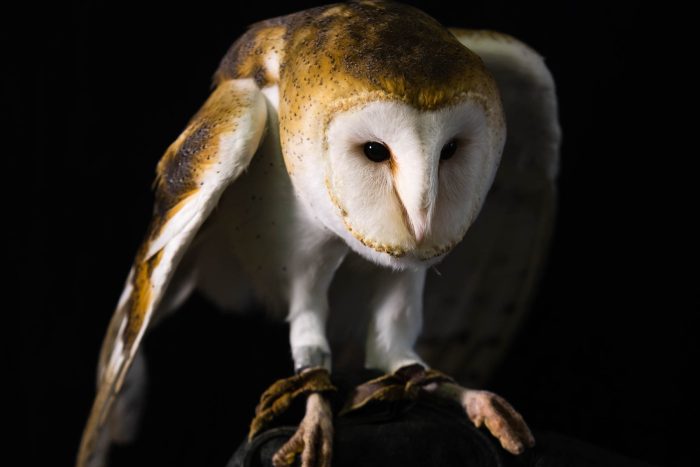Barn Owl
Tyto alba
The barn owl is a medium-sized raptor with a large, heart-shaped face. It is found throughout the Chesapeake region.
This section shows one large critter image at a time. Use the thumbnails that follow to select a specific image to display here.

This gallery contains a grid of small thumbnails. Selecting a thumbnail will change the main image in the preceding section.
Appearance
Barn owls are 12 to 16 inches in length and typically weigh between one and 1.5 pounds. The females tend to be longer and heavier than the males. They have a large, rounded head, a heart-shaped face, a short square tail and long wings and legs. Their feathers are gold or tan with black and white markings.
Feeding
Barn owls hunt at night and eat mostly small mammals like voles, rats, rabbits and shrews. Barn owls have excellent vision and incredible hearing that helps them locate and capture prey even in total darkness. Their soft feathers muffle the sound of their movement, allowing them to sneak up on prey undetected. When hunting, they fly low to the ground, grab their prey with their claws and incapacitate it by biting the back of the neck or head before swallowing it whole. They sometimes store prey for later, especially when they are caring for young.
Predators
Though the young may be eaten by snakes or stoats, adult barn owls have very few predators. However, they do face other challenges to survival, such as limited habitat and nesting sites, ingesting rat poison after eating rats, and getting hit by cars while hunting.
Flight
Barn owls can fly almost silently. Because they have long legs, their feet extend out past the tail when flying. They tend to fly fairly low to the ground. They have a wingspan of approximately 40 inches.
Voice
Barn owls are most vocal during breeding season. They communicate through chirps, snores, hissing and a distinctive gargling scream. They do not hoot.
Reproduction and life cycle
Barn owls usually breed once each year, but in warmer areas may breed as many as three times per year. Breeding can happen at any time throughout the year, and barn owls are often monogamous. Males attract females through flight displays, including a hovering motion known as moth flight. Females lay an average of five or six eggs and incubate them for about a month. Once the young hatch, it takes them 50 to 70 days to learn to fly. The young will reach independence about a month after their first flight. Their average lifespan is only two to four years, though barn owls have been known to live as long as 34 years.
Did you know?
- To keep the nest sanitary, the female will eat the nestlings’ feces until they are old enough to release over the edge of the nest (about 10 days).
- The barn owl’s ability to hunt by sound is one of the most accurate of any animal.
- The scientific name Tyto alba means “white owl.”
- When threatened, a barn owl will spread its wings to appear larger or fall to its back and kick out with its feet.
- Barn owls are very secretive, so it’s difficult for researchers to get accurate population counts.
